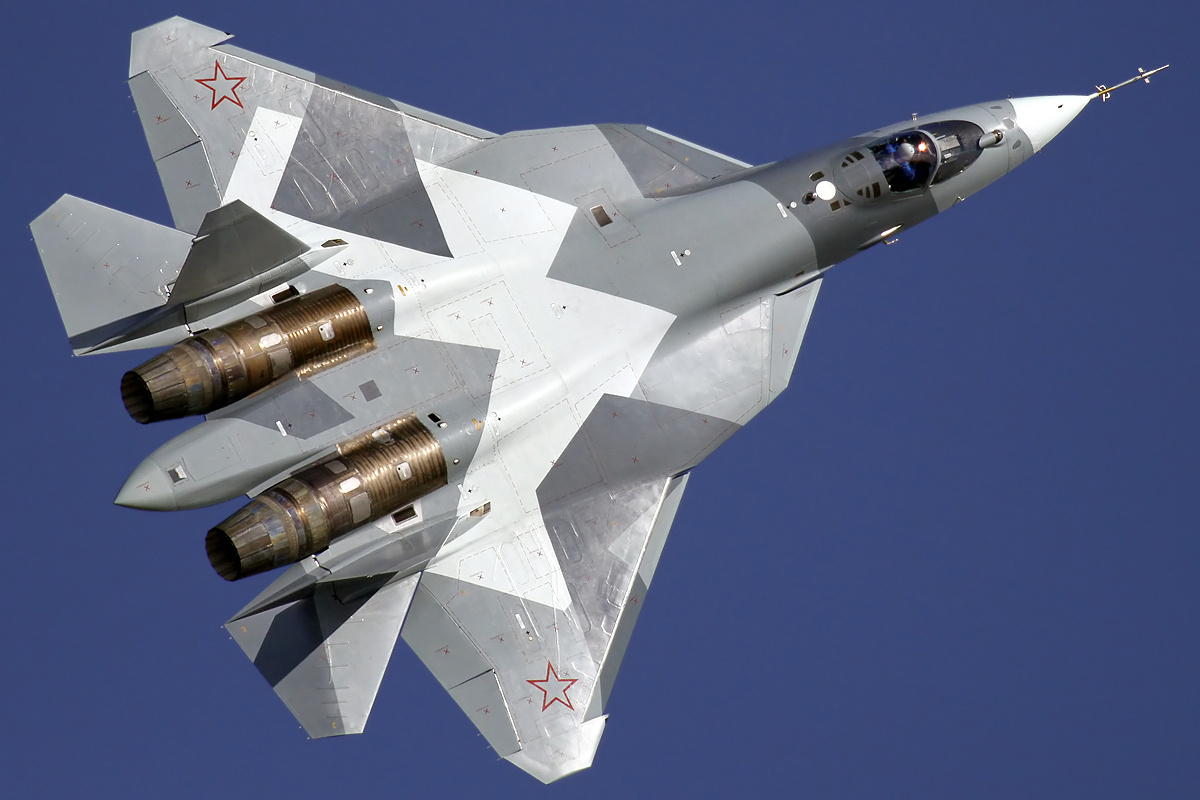“Our country borders a number of states that are pursuing a demonstrably Russophobe foreign policy. F-35 fighters may well turn up in the inventories of some of these states during the coming 15 to 20 years,” warned a Russian official from the State Duma Defence Council in 2010. That same year, Russia’s first fifth-generation stealth fighter jet made its maiden flight. The aircraft in question was the PAK FA T-50.
The PAK FA, which stands for “Prospective Aircraft Complex of Frontline Aviation,” was developed by OKB Sukhoi to replace the existing fleet Su-27s and MiG-29s, offset the existing U.S. and Chinese advantage in stealth technology, and provide a fifth-generation fighter for foreign export. Like the F-22, it is an air-superiority aircraft and not primarily a multi-role aircraft like the F-35, although it has ground-attack capabilities. The PAK FA is currently set to have initial operational capacity and enter service in 2017.
Procurement history
Russia first began developing a stealth fighter aircraft in the late 1980s in response to the U.S. Advanced Tactical Fighter program that eventually produced the F-22 Raptor. However, the MiG 1.44 project was delayed by the dissolution of the Soviet Union and later cancelled in 2000. A year later, the Russian Air Force opened a tender for the PAK FA, which Sukhoi won with its T-50 project over the bids of Mikoyan and Yakovlev.
The initial three prototypes were set for delivery between 2007 and 2009. However, cracks in the first prototype led to structural changes and delays for the production of subsequent T-50s. In 2009, the airframe was assembled for testing with the first prototype beginning flight-testing in January 2010.
The effects of delays, technical problems, and reduced orders were not limited to the Russian military. Since 2007, Russia and India have been developing a variant of the T-50 prototype for the Indian Air Force (IAF) under the name Fifth Generation Fighter Aircraft (FGFA) program. However, the joint venture began to fray early on due to disagreements over technical specifications and cost-sharing, with India decreasing its order from 200 to 144 FGFAs in 2012.
Originally, the plan was for Russia to acquire 52 T-50s by 2020 and 250 by 2030. However, economic difficulties forced revisions in the timeframe, meaning only 12 aircraft will be procured between 2015-2020. To supplement delayed capabilities, the Air Force is hedging its squadrons with Su-35S aircraft. This announcement raised significant doubts in the Indian Air Force, with one senior official stating, “We are not in favor of the FGFA. The PAK FA fighter is too expensive at even this rate, and we are not sure of its capabilities.” In January 2016, India accepted Russia’s offered revision of the agreement with lower investment costs for the FGFA. Regardless, the IAF remains concerned about enduring technical problems with the aircraft.
Fifth-generation? “A matter of perspective”
While the Russian government has touted the aircraft’s superior capabilities, defence officials and analysts in the U.S. remain skeptical about whether it qualifies as a truly fifth-generation fighter. The general elements that constitute such an aircraft include stealth technology, supersonic cruise ability, integrated avionics, and advanced electronics.
The T-50 prototypes are currently fitted with the Saturn 116 engine, NIIP Irbis radar, and certain avionics that are also on the Su-35S. These components will be phased out after 2020 when the upgraded components are ready for production. Current estimates suggest that the new engine, the Izdeliye 30, will enter service in 2020.
One industry official suggested that the T-50 resembles the F/A-18E/F or F-16/E/F in terms of avionics, and would better classify as a 4.5-generation rather than a fifth-generation fighter. However, once the necessary subsystems are introduced after 2020, the T-50 is expected to qualify as a fifth-generation aircraft.
Is it better than the F-35 and the F-22?
“It will be no worse than US analogues, F-22 and F-35, and will exceed them in all parameters,” said a Russian Air Force commander.
Many of the technical details are still classified, especially since the program is still not in the main production stage. However, the general consensus is that the T-50 is more manoeuvrable than the F-35 and F-22, but less stealthy. The T-50 has a comparative advantage in air engagements, but is less capable as a ground-attack aircraft. Compared to the F-22, the PAK FA is faster, has a longer operational range, and better target detection.
“It certainly has greater agility with its combination of thrust vectoring, all moving tail surfaces, and excellent aerodynamic design, than does the F-35,” said former U.S. Air Force intelligence chief Lt. General Deptula.
While the T-50 is highly manoeuvrable and possesses advanced avionics, it remains to be seen how well it integrates with existing command, control, and communication systems. Before the necessary components are upgraded, the T-50 will be missing some additional capabilities that decrease its operational capabilities. Given the expressed dissatisfaction of the Indian Air Force, the hyperbole expressed by the Russian government for the aircraft’s capabilities should be taken with some skepticism.
Regardless, the PAK FA will carry an impressive array of missiles capable of engaging other aircraft such as AWACS, C4ISTARs, and fighters at long ranges, in addition to ships, radars, and other surface targets.
Nevertheless, just as the much-extolled T-14 Armata tank ground to a halt on the Red Square in May 2015, the T-50 may have a turbulent start when it enters service in 2017. But the introduction of the PAK FA will certainly improve the Russian Air Force’s operational capacity in environments contested by hostile aircraft and air-defence systems.
Photo courtesy of Dmitry Zherdin (Creative Commons).




